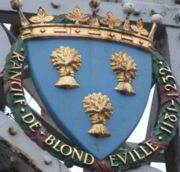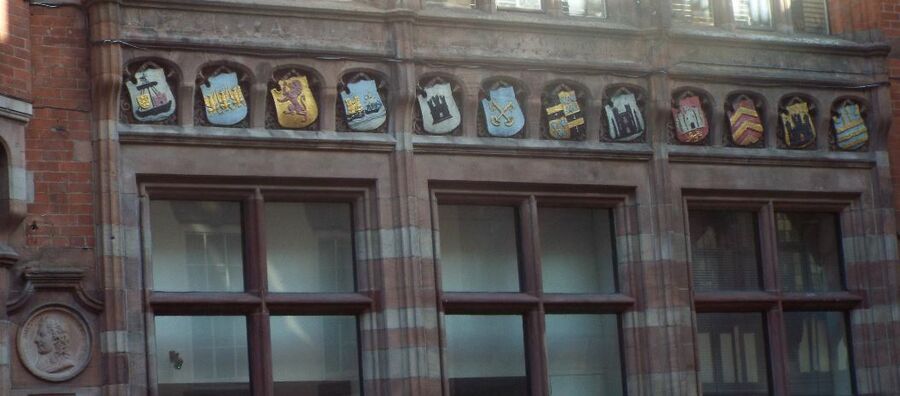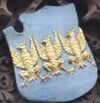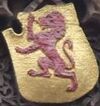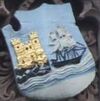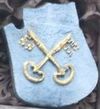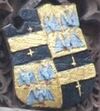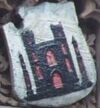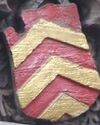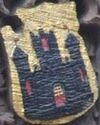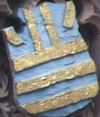Grosvenor Club
"Coats of Arms" can be found all over Chester (see: Chester Heraldry Tour) and Chester has associations with heraldry through Randle Holme the deputy Chester herald (who lived in Bridge Street). One interesting example of arms is found on the front of what was once the Grosvenor Club next to the Eastgate. Other notable examples are on the Suspension Bridge, in the Town Hall and in various pubs and churches.
The Building
Number 47 Eastgate Street was originally a Gentlemens Club and bank. It was constructed 1883-4 and designed by Douglas and Fordham, it was enlarged in 1908. The bank was a Welsh bank (The North & South Wales Bank, established in 1836), hence the first storey frieze bears shields with (supposedly) the arms of twelve of the thirteen former shires of Wales (excluding Monmouthshire).
In the lintel over the doorway in the entrance bay is a carving of the portcullis from the Grosvenor coat of arms. Above the door is a three-storey canted oriel window carried on corbels; between the corbels are two more coats of arms - the three sheaves as used by Ranulf de Blondeville which later became an emblem of Cheshire generally, and, the Arms of Chester city arms which combine the Royal arms of England - a red shield with three gold lions - and those of the earldom.
The windows are all mullioned, those in the middle storey also having two transoms, and that in the upper storey has a transom. Between the windows is brick diapering. At the summit of this bay is a spire with a lead finial. To the left of the entrance bay is a wing containing two mullioned and transomed windows in each storey; the left-hand window in the middle storey is a canted oriel window. Centrally at the summit is another spire with a lead finial. To the right of the entrance bay are three mullioned and transomed windows in each storey, plus a two-light window in the gable. Centrally between the middle and top-storey windows is the Grosvenors coat of arms. Above the top-storey windows is the gilded date "1883". Over the window in the attic is the sheaf (garb) from the Grosvenor arms.
The Bank
Despite its name, the North and South Wales Bank (also known as the Wales Bank) was formed in Liverpool in 1836 and was originally located in premises in James Street, Liverpool (having been in Cook Street while these were being built). It remained headquartered in Liverpool during its entire existence. The development of financial services in Liverpool was closely linked to the cotton trade which would have a significant impact on the history of the bank.
The bank envisaged a branch system that would extend throughout Wales, despite the challenges concerning transport and communication. There were few railways in Wales at this time: the North Wales Mineral Railway would open in 1846 as the Shrewsbury and Chester Railway. The lines would be developed by the likes of the Wrexham, Mold and Connah's Quay Railway. In it's early days the bank would largely serve agricultural business in North Wales, but would soon expand to serve industrial, trading and shipping customers around Liverpool. The bank was funded by the sale of shares and followed the usual pattern at the time that a £20 share could be purchased for £10 paid up-front with the remaining £10 being a risk that the shareholder might be called-upon to pay if the bank needed more capital. Potentially worse still, the shareholders were (until after 1857) liable to an unlimited extent for any losses that the bank might incur.
The boom in joint-stock banking started when joint stock banks with more than six partners were legalised outside London (65-mile radius from the city) with the Bank Co-partnership Act of 1826 (which also prohibited all bank notes under £5). Until then commercial banking had been conducted by small partnerships, and firms of this kind increased rapidly in number to serve the expanding activity in trade and commerce which followed the Industrial Revolution. By the first decade of the nineteenth century over seven hundred country banks were in existence, many having developed as a side line to trading or manufacturing activities, and nearly all of them issued their own banknotes notes. As a result of the deregulation in 1826, within 10 years over 100 joint stock banks were established, 59 in 1836 alone. 1836 also saw the start of a new phase of "railway mania" and money began to move around with increasing speed creating opportunities both for enormous gains and enormous losses, both in railway investments and in the growing cotton industry. The N&SWB was financed to a significant extent by the Welsh builders who prospered in Liverpool during its rapid period of growth, and largely staffed by Welshmen, who were usually familiar with the bank's customers. Almost all of the clerks were either born in Liverpool or in the market towns of north Wales (Wrexham, Holyhead, Llanrwst) where the bank opened branches. The HSBC group archives contain the following information on the N&SWB:

- "The provisional committee, composed mainly of Liverpool merchants, manufacturers and business men, appointed a deputation to visit Welsh towns and London in order to obtain support of nobility and gentry and of Welsh Members of Parliament. In order, as described in the Minutes of the Meetings of the Provisional Committee, "to convey the impression of this Bank being as it ought to be national in its principles with the intention of national in its practice", the committee recommended that trustees should be selected from the Welsh nobility and gentry and that most of the shares should be reserved for Welsh investors. The Bank opened in April 1836 in temporary premises in Cook Street, Liverpool pending the erection of a new building in James Street. Arrangements had already been made to take out a note licence covering 22 towns in North and mid-Wales. Deputations were sent through Wales with "full powers to treat with any bank or bankers for the purchase of the business of their establishments and also for the appointment of any clerk or clerks they may think fit ... with a view to open banks". A meeting of the shareholders of the North and South Wales Bank was called to decide whether Liverpool branch should conduct business. This was agreed to because "Liverpool is treated as the commercial metropolis of North Wales". Six branches were soon opened in North Wales and a deputation was sent to South Wales.
The idea that Liverpool was "the capital of North Wales" was not confined to the N&SWB. At the beginning of the 19th century there were at least 90 Welsh chapels and mission halls on Merseyside, there were three clear ethnic Welsh communities in Toxteth Park, Vauxhall and Everton. Saunders Lewis, a founder of Plaid Cymru (who was born in Wallasey) once said:
- "The notion that I was born outside Wales is totally incorrect. I’m fairly certain there was a Welsh population of about 100,000 in Merseyside during my boyhood and I would say that at least half of those were monoglot Welsh speakers."
The advent of joint-stock banking had a major impact on bank architecture with many banks, particularly in the north of England and especially in Manchester, being built with impressive frontage to give the impression of wealth, reserve and solidity and thereby attract both custom and share-capital. Other examples of banks in Chester demonstrate this use of architecture as part of an overall business get-up. The new bank immediately took over the business of several private banks. At the same time branches were established in several towns in North Wales and a deputation was sent to South Wales: equipped with "a phaeton and a good strong horse". The original plans for expansion came to a halt with the collapse of the Northern & Central Bank of England, a Manchester bank with 40 branches, many in North Wales. The Manchester bank was typical of northern UK banks that were involved in the cotton trade with the US, which was then very dependent on credit originating in the UK, especially in Manchester and Liverpool. Many of these loans became problematic and combined with other factors led to the transatlantic bank crisis that would become known as the "Panic of 1837".
Eight of these were taken over by the Wales Bank which managed to survive this turbulent period, and which by the end of the first year had 13 branches and 10 sub-branches. The Chester branch was among those opened in the first year (4th July 1836). Once the effects of the 1837 crisis had passed, the years 1868-95 were prosperous for the Wales Bank and healthy dividends of typically 17.5% were paid on shares. By the beginning of the 20th century, however, the country business had declined and business tended to stagnate. Large interests in the cotton industry, with its heavy seasonal demands, were still increasingly difficult to handle and the American financial crisis of 1907 (the "Panic of 1907") precipitated the decision to agree to an amalgamation with Midland. At the time of the merger in November 1908, there were 84 branches and 24 sub-branches; paid-up capital was £750,000, reserves £512,000, deposits £11 million and advances and bills £7.5 millions.
The last Welsh bank notes were withdrawn from circulation in 1908 by the North and South Wales Bank, when it was taken over by the Midland Bank.
The Club
Little is known about the "Gentlemen's Club" other the the fact that the members seemed to spend a lot of time "black-balling" new applicants for membership. The co-location of the gentleman's club and the bank was not a unique feature in Chester, as a similar situation was found in Northgate Street: when the Commercial News Rooms were first built the ground floor fronting onto Northgate Street was occupied by the "Rowton and Morhall's Bank", founded in 1805 and becoming insolvent on the 10th July 1810. In that case the bank failed and the club survived.
The Welsh Arms
The Historic Counties of Wales were: Glamorgan, Carmarthenshire, Pembrokeshire, Cardiganshire, Brecknockshire, Radnorshire, Montgomeryshire, Denbighshire, Flintshire, Merionethshire, Caernarfonshire and Anglesey. Monmouthshire was at various times counted as an English county, although it is a member of the original 13. The shields are a stylised form of a "heater shield" - a neologism, created by Victorian antiquarians due to the shape's resemblance to a clothes iron. From the 15th century, it evolved into highly specialized jousting shields, often containing a bouche, a notch or "mouth" for the lance to pass through. Heraldry in Wales has a tradition distinct from that of English and Scottish heraldry. There is evidence that heraldry was already being used in Wales by the middle of the thirteenth century; for instance, in Gwynedd, two sons of Llywelyn the Great are recorded as having borne coats of arms in this period. Following the integration of Wales into England in the fourteenth and fifteenth centuries, the Welsh heraldic tradition became merged into that of England. Before the conquest of Gwynedd by Edward I, Wales was ruled by a number of Kings and Princes whose dominions shifted and sometimes merged following the vagaries of war, marriage and inheritance. All these Kings and Princes were ascribed personal coats of arms, often retrospectively as "attributed" arms, if they lived before the dawn of heraldry, and these were borne by their descendants in Wales.
It is not evident at first glance which arms are associated with each county. The arms include some clear cases: three golden eagles (Caernarfonshire) and bats and daggers (Brecknockshire). However some are less clear: a white castle and a golden lion may also be Caernarfonshire, and chevrons could be Glamorgan. It is hard to identify which are the arms of Cardiganshire, Pembrokeshire, Merionethshire or Anglesey. Several of the arms appear to be related to the arms or seal of the county town. There is also a general trend that from left to right the arms are those of the historic counties from to north to south.
The historic counties of Wales were used for various functions for several hundred years, but have been largely superseded by contemporary sub-national divisions. The 1535 Laws in Wales Act had the effect of abolishing the marcher lordships within and on the borders of Wales. In the border areas, several were incorporated in whole or in part into English counties. The lordships of Ludlow, Clun, Caus and part of Montgomery were incorporated into Shropshire; and Wigmore, Huntington, Clifford and most of Ewyas were included in Herefordshire. The territory which became Monmouthshire was part of the Welsh kingdoms of Gwent and Glywysing and later, after the Norman conquest of southern Wales, of the Welsh Marches. Although the original Laws in Wales Act of 1535 specifically stated the lands making up Monmouthshire were from the 'Country or Dominion of Wales', the Laws in Wales Act 1542 added Monmouthshire to the Oxford circuit of the English Assizes rather than falling under the Court of Great Sessions in Wales. This arrangement was the cause of the erroneous belief that the county had been annexed by England rather than remaining part of Wales. In later centuries, some English historians, map-makers, landowners and politicians took the view that Monmouthshire was an English rather than a Welsh county, and references were often made in legislation to "Wales and Monmouthshire". The position was finally resolved by the Local Government Act 1972, which confirmed Monmouthshire's place within Wales. The Laws of Wales act contains some quite amusing language, and declared King Henry's intentions, that because of differences in law and language:
- (4) some rude and ignorant People have made Distinction and Diversity between the King's Subjects of this Realm, and his Subjects of the said Dominion and Principality of Wales, whereby great Discord, Variance, Debate, Division, Murmur and Sedition hath grown between his said Subjects;
- (5) His Highness therefore of a singular Zeal, Love and Favour that he beareth towards his Subjects of his said Dominion of Wales, minding and intending to reduce them to the perfect Order, Notice and Knowledge of his Laws of this Realm, and utterly to extirp all and singular the sinister Usages and Customs differing from the same, and to bring the said Subjects of this his Realm, and of his said Dominion of Wales, to an amicable Concord and Unity...
From the conquest of Gwynedd in 1282–83 until the passing of the Laws in Wales Acts, the administrative system of Wales had remained unchanged. By the Statute of Rhuddlan in 1284 the territory of the native Welsh rulers had been broken up into the five counties of Anglesey, Caernarfon, Cardigan, Carmarthen, and Merioneth. Even though the five counties were subject to English criminal law, the "Principality" was the king of England's own personal fief and Welsh law continued to be used for civil cases. The rest of Wales, except for the county of Flint, which was part of the Principality, and the Royal lordships of Glamorgan and Pembroke, was made up of numerous small lordships, each with its own courts, laws and other customs.
When Henry Tudor, Earl of Richmond (descended from an Anglesey landowning family) seized the English throne in 1485, becoming Henry VII, no change was made to the system of governing Wales, though he remained concerned about the power of the Marcher Lords and the lawlessness and disorder in the Welsh Marches. To deal with this there was a revival of the Council of Wales and the Marches, which had been established in the reign of Edward IV. After the deaths of many of the Marcher lords during the Wars of the Roses, many of the lordships had passed into the hands of the crown. The Court of the Council in the Dominion and Principality of Wales, and the Marches of the same, commonly called the Council of Wales and the Marches (Welsh: Cyngor Cymru a'r Gororau) was a regional administrative body based in Ludlow Castle within the Kingdom of England between the 15th and 17th centuries, similar to the Council of the North. Its area of responsibility varied but generally covered all of modern Wales and the Welsh Marches (sometimes called "Welsh Lost Lands") which included parts of Shropshire, Herefordshire, Worcestershire, Cheshire and Gloucestershire/Bristol.
First Set
The first four shields are the arms of counties in North Wales:
Anglesey
- Ship with gold shield bearing three lions and red castle. Possibly Anglesey, due to the castle being surrounded by water. Apart from thr colours, the image is almost identical to the the borough arms of Beaumaris, the former county town, as depicted on a WD & HO Wills cigarette card dating from 1904. Beaumaris was originally a Viking settlement known as Porth y Wygyr ("Port of the Vikings"). This may have been the first stop of the Hiberno-Norse Ingimund who was expelled from Dublin and later settled in the Wirral. The town itself began its development in 1295 when Edward I of England, having conquered Wales, commissioned the building of Beaumaris Castle as part of a chain of fortifications around the North Wales coast. The arms also appear in a chromolithograph catalogue of "Monograms and Heraldic Designs" by Wilkinson, Heywood & Clark Ltd, 7 Caledonian Road, London dated to around 1907. Three lions as the personal arms of the Plantagenet kings of England were first adopted from the reign of Richard I (1189–1199). Beaumaris was the port of registration for all vessels in North West Wales, covering every harbour on Anglesey and all the ports from Conwy to Pwllheli. In medieval times, before the conquest of Wales in 1283, Môn often had periods of temporary independence, as it was frequently bequeathed to the heirs of kings as a sub-kingdom of Gwynedd. The last times this occurred were a few years after 1171, following the death of Owain Gwynedd, when the island was inherited by Rhodri ab Owain Gwynedd, and between 1246 and c. 1255, when it was granted to Owain Goch as his share of the kingdom. After the conquest of Wales by Edward I, Anglesey was created a county under the terms of the Statute of Rhuddlan of 1284. Prior to this it had been divided into the cantrefi of Aberffraw, Rhosyr and Cemaes.
Caernarfonshire
- Three golden eagles (Caernarfonshire):- originally attributed to the 12th century king, Owain Gwynedd, king of Gwynedd. The county was originally created under the terms of the Statute of Rhuddlan in 1284 following Edward I of England's conquest of the Principality of Wales and included the cantrefi of: Llŷn, Arfon, Arllechwedd and the commote of Eifionydd (the northern portion of Dunoding). There is no evidence Owain used a coat of arms during his life, but later antiquarians retroactively attributed to Owain Gwynedd the blazon: Vert, three eagles displayed in fess Or. Owain Gwynedd was born around 1100 and became King of Gwynedd in 1137. However, although heraldic devices and arms started being used in Wales from 1150 they did not start becoming commonplace for nobility until 1300. In 1415, the Battle of Agincourt was fought in which the Caernarfonshire units were reputed to have fought under a banner of three golden eagles on green in honour of Owain Gwynedd, as mentioned by the seventeenth century poet and historian Michael Drayton. The earliest surviving depiction of these arms appears to be a brass memorial for Maredudd ap Ieuan ap Robert, a supposed descendant of Owain Gwynedd who died in 1525, which can be found in Dolwyddelan Church. Apart from the actual eagles living in the county, it is possible that the symbolism harks back to the Roman eagle (and the Roman fort at Segontium (modern Caernarfon) constructed around 77 AD. Three eagles also appeared on the three turrets of the "Eagle Tower" at Caernarfon Castle. The tower contained grand lodgings, and was probably built for Sir Otton de Grandson (c. 1238–1328), the first justiciar of Wales (1284-94) and a benefactor of Vale Royal. It also appears in the Kaffee Hag collection as Caernavon.
Montgomeryshire
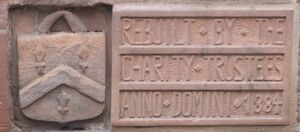
- Rampant red lion on gold:- appears in the arms of the kingdom of Powys Wenwynwyn (also known as Powys Cyfeiliog) and in the earlier arms of the Kingdom of Powys. The main center of government was at Mathrafal in historic Montgomeryshire. The arms are believed to have been used (as a banner) by Bleddyn ap Cynfyn (died 1075). Harold Godwinson and Tostig Godwinson installed him and his brother, Rhiwallon, as the co-rulers of Gwynedd on his father's death in 1063, during their destruction of the kingdom of Bleddyn's half-brother, Gruffydd ap Llywelyn. He became king of Powys and co-ruler of the Kingdom of Powys with his brother Rhiwallon from 1063 to 1075. His descendants continued to rule Powys as the House of Mathrafal. The Lords of Powis continued to use the old banner of Powys for their personal arms and, as such, the banner continued to be associated with the territory, until at least 1421 when ownership of the lordship passed outside the Anglo-Welsh Charleton family. In 1573 the Lordship was transformed into the County of Montgomeryshire by the Laws in Wales Acts however there is compelling evidence that the shire continued to be popularly represented by the banner of arms of Powys because a book published in 1894 illustrates the shields of the counties of Wales and shows Montgomeryshire using a red lion device and the motto 'POWYS PARADWYS CYMRU'. The arms are identical to those of Ranulf de Meschines. Ranulf de Meschines has arms which are, on the Queens Park Suspension Bridge, a white lion on a red ground and, in the stained glass of the Town Hall, possibly a red lion on a gold ground. To add further confusion some versions of the arms of his son Ranulph De Gernon (shown in the church window on his page) and that shown on the bridge also differ - the window shows a metallic lion on a red field, while the bridge shows the opposite. Before the formal award of arms to the former Montgomeryshire County Council, the body made use of the arms of the old kingdom of Powys as reported in the 1894 Book of Public Arms by Arthur Fox Davies.
Flintshire
- Gold castle and ship at sea. Possibly Flintshire - the castle upon a rock and ship are possibly taken from the ancient borough seal of Flint and show that Flint is a sea port with a castle on a rugged coastline. Building at Flint castle began in 1277 initially under Richard L'engenour, who would later become Mayor of Chester in 1304. The castle and its earthworks were built by 1,800 laborers and masons using local Millstone Grit ashlar and sandstone. Savoyard master mason James of Saint George was assigned "ad ordiandum opera castorum ibidem" (to undertake the works of the same castle works (referring to all Welsh castle building projects)) in April 1278. The arms of Flintshire itself are quite distinct with a cross and birds taken from the supposed arms of Edwin King of Tegeingl, a former Kingdom that covered most of the present county. However, these are very similar to the attributed arms of Edward the Confessor, which only appear to have been first used by Richard II and is based on a coin of Edward the Confessor. Richard II (1377–1399) impaled this coat with the Plantagenet arms, and it later became the basis of the arms of Westminster Abbey, in which The Confessor was buried, and of Westminster School, founded within its precinct. Richard II surrendered to Henry Bolinbroke (later Henry IV) at Flint castle and then taken to Chester Castle were he was briefly held before being transferred to London (see: Royal Treasure). The county of Flintshire was formed in 1284 under the terms of the Statute of Rhuddlan, following the defeat of the Principality of Wales. However, the region had been English since the 8th century, and formed part of Cheshire until it was recaptured by the Welsh in the late 12th century.
Second Set
Merionethshire
- Black castle: by elimination (if all others are correct) this would be Merionethshire, but does not feature the more familiar leaping goats. This in turn derived from the description of a banner borne by the men of Merioneth at the Battle of Agincourt, in the 17th century poem of the same name by Michael Drayton. Here he wrote of “three goats dancing "gainst a rising sun"; the shield was blue, the sun golden and the goats white. Speculation regarding this unusual arrangement suggests a connection with Cader Idris, where goats browsed and behind which the sun rose. Identification of the actual castle shown is only tentative. The most famous castle in the area being Harlech Castle built by Edward I during his invasion of Wales between 1282 and 1289, but looks nothing like the castle shown on the shield: something which is to be expected as heraldic castles tend to follow the pattern shown here with three towers - a central one and one to either side. This one may well have been difficult for people to recognise as unlike the others it offers no real clues as to the location with which it is associated. The region which became Merionethshire previously constituted the Cantrefs of Meirionydd and Penllyn, and the Commote of Ardudwy. Prior to the 10th century, Ardudwy formed part of the principality of Dunoding, while Meirionydd and Penllyn were part of Powys. In 1284, King Edward I issued the Statute of Rhuddlan, terminating Gwynedd's existence as a state. The former appanage of Ardudwy-Merionydd, together with Penllyn, which had been part of Gwynedd for less than 150 years, were converted into Merionethshire (taking the name from Meirionydd).
Denbighshire
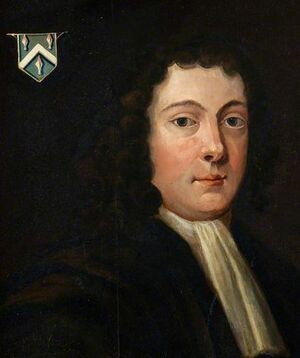
- Crossed keys:- appear above the shield in the "official" arms of Denbighshire and also appear in the arms of the diocese of St Asaph. Under the Local Government Act 1972, the use of Historic Denbighshire for local government and ceremonial purposes ended on 1 April 1974, with the creation of the new county of Clwyd. A different county of Denbighshire was created on 1 April 1996, for modern local government purposes, covering a substantially different area from the historic county. The original historic county was created by the Laws in Wales Acts 1535-1542 from areas previously in the Marches. Significant parts came from the Lordship of Denbigh which was a marcher lordship in North Wales created by Edward I in 1284 and granted to the Earl of Lincoln. It was centred on the borough of Denbigh and Denbigh Castle. The lordship was held successively by several of England's most prominent aristocratic families in the 14th and 15th centuries. Title to the lordship was disputed for much of the second half of the 14th century between two powerful noble families: the Mortimer Earls of March and the Montagu Earls of Salisbury. Eventually, the lordship returned to the crown when Edward, Duke of York, who had inherited the lordship through his grandmother, acceded to the throne in 1461 as Edward IV. In 1563, Elizabeth I revived the lordship and granted it to her favourite Lord Robert Dudley, later becoming the Earl of Leicester. Leicester mortgaged it to raise money and the lordship was finally returned to the crown when Elizabeth redeemed the mortgage in 1592/3. The crown disposed of much of the lordship's lands over the following centuries. Although the lordship still technically exists, with the Queen as its holder, its remaining lands, chiefly common land (for example, on Denbigh moors), are vested in the Crown Estate. The Crown Estate also conducts the annual Lordship of Denbigh Estray Court which continues to exercise a historic jurisdiction over the area's stray sheep.
Brecknockshire
- Bats and daggers (Brecknockshire):- based on the supposed arms of Brychan a legendary 5th-century king of Brecknockshire under whose leadership the Goidels reoccupied the Usk Valley on the withdrawal of the Romans. The swords/daggers are for Prince Anlach, Brychan's father and the blue "reremice" or bats are for Marchell, his mother. According to Celtic hagiography Brychan was born in Ireland, the son of a Prince Anlach, son of Coronac, and his wife, Marchel, heiress of the Welsh kingdom of Garthmadrun (Brycheiniog), which the couple later inherited. Upon his father's death, he returned to Garthmadrun and changed its name to Brycheiniog. Brychan's name may be a Welsh version of the Irish name Broccán and that of his grandfather Coronac may represent Cormac. Bernard de Neufmarché was a minor Norman lord who rose to power in the Welsh Marches before successfully undertaking the invasion and conquest of the Kingdom of Brycheiniog between 1088 and 1095. Bernard established a Marcher Lordship in its place – the Lordship of Brecknock. The lordship was ruled by numerous families over the next 400 years. By the early Tudor period, it was ruled by the Earls of Buckingham. When Edward Stafford, 3rd Duke of Buckingham, was executed for treason, having been suspected of plotting against King Henry VIII, the Lordship was forfeited to the crown. Henry VIII combined it with the cantref of Buellt. By his Laws in Wales Acts, Henry converted the combined territory - the Lordships of Brecknock and Buellt - into Brecknockshire, subject to standard English law.
Cardiganshire
- Black castle with separate flanking towers (Cardiganshire?):- similar to the seal listed in the Kaffee Hag collection. During the second half of the first millennium Ceredigion was a minor kingdom. It has been administered as a county since 1282. The 9th-century History of the Britons attributed to Nennius records that Cunedda's son Ceredig settled the area around the Teifi in the 5th century. The territory supposedly remained a minor kingdom under his dynasty until its extinction upon the drowning of Gwgon ap Meurig c. 871 (the Chronicle of the Princes places his death in the entry for 870 and says he drowned crossing the River Llychwr in Gower while fighting Viking invaders.) leaving no heir. Gwgon's sister, Angharad, was married to Rhodri the Great of Gwynedd, who became steward over Gwgon's realm. While this gave Rhodri no standing to press a claim to kingship himself, he was able to install his and Angharad's younger son, Cadell, as the new King of Seisyllwg. Cadell ruled as a vassal to his father, and later, to his elder brother Anarawd. Cadell's son Hywel Dda inherited its neighbouring kingdom Dyfed and established the realm of Deheubarth after he merged Seisyllwg and Dyfed. In 942 Hywel's cousin Idwal Foel, King of Gwynedd, determined to cast off English overlordship and took up arms against the new English king, Edmund. Idwal and his brother Elisedd were both killed in battle against Edmund's forces. By normal custom Idwal's crown should have passed to his sons, but Hywel intervened. He sent Iago and Ieuaf into exile and established himself as ruler over Gwynedd, which also likely placed him in control of the Kingdom of Powys, which was under the authority of Gwynedd. As such Hywel became king of nearly all of Wales except for Morgannwg and Gwent in the south. Hywel's reign was a violent one, but he achieved an understanding with Athelstan of England whereby Athelstan and Hywel ruled part of Wales jointly. Such was the relationship between the neighbouring countries that Hywel was able to use Athelstan's mint at Chester to produce his own silver pennies.
Third Set
Carmarthenshire
- White castle and golden lion (Carmarthenshire?):- the castle above the lion appears on the arms of the Carmarthen town council (granted 9th April 1936, to the Carmarthen Borough Council, but based on a seal in previous use). Two ostrich feathers are arranged at the sides of the castle and atop each of the outer towers of the castle is perched a Cornish Chough. Since the 14th century, St Thomas Becket (d.1170), Archbishop of Canterbury, has retrospectively acquired an attributed coat of arms consisting of three Cornish choughs on a white field,[57] although as he died 30 to 45 years before the start of the age of heraldry, in reality he bore no arms. These attributed arms appear in many English churches dedicated to him. The symbolism behind the association is not known for certain. According to one legend, a chough strayed into Canterbury Cathedral during Becket's murder. The lion may have been derived from the arms ascribed to Cadell, Prince of South Wales in the last part of the ninth century. Carmarthenshire has its early roots in the region formerly known as Ystrad Tywi ("Vale of [the river] Tywi") and part of the Kingdom of Deheubarth during the High Middle Ages, with the court at Dinefwr. After the Normans had subjugated England they tried to subdue Wales. Carmarthenshire was disputed between the Normans and the Welsh lords and many of the castles built around this time, first of wood and then stone, changed hands several times. Following the Conquest of Wales by Edward I, the region was reorganized by the Statute of Rhuddlan in 1284 into Carmarthenshire.
Glamorgan

- Red and gold chevrons (Glamorgan):- The gold shield with three red chevronels was the arms of the de Clare family, who first settled in Clare, Suffolk but then later became the Norman Lords of Glamorgan. They are also the attributed arms of Iestyn ap Gwrgant (1014 – 1093) the last ruler of the Welsh kingdom of Morgannwg, which encompassed the counties of Glamorgan and Monmouthshire. The chronology of the Norman conquest of Glamorgan is disputed, but it appears that the subjugation of Glamorgan, begun by Robert Fitzhamon, was finally completed by the powerful de Clare family. In 1486 the castle was granted to Jasper Tudor. The current arms of the county of Glamorgan also employ red chevrons. Clearly there is a question as to whether the arms were in use in Glamorgan prior to the arrival of the de Clare family. According to some accounts the family was originally from Clere, in Vexin, Normandy, but a better explanation seems to be that they were the descendants of Richard fitz Gilbert (before 1035–c. 1090) styled "de Bienfaite", "de Clare", and of "Tonbridge" from his holdings including Clare castle. In 1110, King Henry I took Cardigan from Owain ap Cadwgan, son of Cadwgan ap Bleddyn as punishment for a number of crimes including that of the abduction of Nest, wife of Gerald de Windsor. In turn Henry gave the Lordship of Cardigan, including Cardigan Castle to Gilbert Fitz Richard, son of Richard Fitz Gilbert (de Clare). The Tudors claimed descent, through Jasper Tudor, from Marchudd ap Cynan, Lord of Rhos, 'protector' of Rhodri Mawr, King of Gwynedd.
Pembrokeshire
- Black castle with steeples and flags (Pembrokeshire?):- similar to the seal used by Pembroke prior to the grant of arms. Henry VII was born at Pembroke Castle in 1457 and one of his badges was a portcullis. Between 350 and 400, an Irish tribe known as the Déisi settled in the region known to the Romans as Demetae. The Déisi merged with the local Welsh, with the regional name underlying Demetae evolving into Dyfed (it is not quite clear how), which existed as an independent petty kingdom from the 5th century. Dyfed remained an integral province of Deheubarth, but this was contested by invading Normans and Flemings who arrived between 1067 and 1111. The region became known as Pembroke (sometimes archaic "Penbroke"), after the Norman "Pembroke" castle first built in the cantref of Penfro by Arnulf de Montgomery. At the turn of the twelfth century Arnulf's lordship included much of the former Welsh Kingdom of Deheubarth as well as various lands in Yorkshire. Not long after reaching this apex of his career, Arnulf assisted his eldest surviving brother, Robert de Bellême, in a rebellion against Henry I, King of England. It was also about this time that Arnulf married a daughter of Muirchertach Ua Briain, King of Munster, in what appears to have been an effort to gain military support against the English Crown. Following the ultimate collapse of the rebellion, however, the Montgomerys were outlawed and banished. In 1189, Pembroke Castle was acquired by William Marshal. He soon became Lord Marshal of England, and set about turning the earth and wood fort into an impressive Norman stone castle. The Laws in Wales Act 1535 effectively abolished the powers of the Marcher Lords and divided the county into seven hundreds, roughly corresponding to the seven pre-Norman cantrefi of Dyfed.
Radnorshire
- Blue and gold stripes (Radnorshire):- it would seem that a variation of the banner of the arms of the Mortimer family. In the Middle Ages, the Mortimers were a powerful magnate family or dynasty of Marcher Lords in the Welsh Marches, centered on Wigmore Castle in Herefordshire, and from the 14th century holding the title of Earl of March. The geographic territory of the historic county roughly corresponds with the Welsh territory of Rhwng Gwy a Hafren (English: Between Wye and Severn) which fell under the control of the Marcher Lords at the end of the 11th Century. Through marriage, the Mortimers came during the reign of Richard II to be close to the English throne, but when Richard II was deposed in 1399 (see: Royal Treasure), the claims of the Mortimers were ignored and the throne vested in the usurper Henry of Lancaster instead. The Mortimer claims were later (1425) transmitted to the House of York, which ultimately claimed them in the Wars of the Roses. The Mortimers possibly devised their arms as an heraldic representation of the Dead Sea, from which the family "de Mortuo Mari" were supposed to have derived their name, although there are other possible explanations; the silver escutcheon at the top of the family arms (omited on this shield) may be intended to stand for the waters, and the gold and blue pieces about the sands and sky. The other origins of the name include the more likely story that it is derived from Mortemer Abbey (French: L'Abbaye de Mortemer) a former Cistercian monastery in the Forest of Lyons between the present Lyons-la-Forêt and Lisors, some 34 km (21 mi) southeast of Rouen. The stagnant water of the drainage lake, dug out by the monks to dry up the marshy land around the quick-running Fouillebroc stream, was called the "dead pond" - in French "morte mare" - and gave the monastery its name. The village of Mortemer, further north in the Seine-Maritime area, bears the same name and predates the abbey at Lisors by more than one hundred years.
Summary
This building shows how many threads of the history of Chester are woven together. The bank itself was closely linked to the growth of financial markets in Liverpool, many of which were involved with the cotton trade. The growth of the Port of Liverpool and cotton trade was one reason why Chester's traditional role as a linen port declined. The decorative style of the bank is designed to advertise both wealth and tradition and it has curious links to the Owen Jones charity and its "interesting" financial history. The use of the arms of the "historic counties of Wales" is interesting if only because much of the symbolism used is derived from either castles built by invaders of Wales or the personal arms of those who invaded it.
Sources and Links
Related Pages
- Owen Jones: the benefactor of a charity;
Online
- Grosvenor Club and North and South Wales Bank: the building on Wikipedia;
- The North and South Wales Bank: the bank on Wikipedia;
- Listed building record;]
- Welsh County Flags
- Kaffee Hag listing of arms of towns and cities (1933) - from "Heraldry of the world".
- The development of Welsh heraldry.
